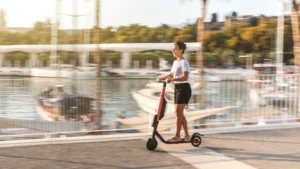Electric scooters, or battery scooties, have become a popular choice for eco-conscious and budget-savvy commuters. With advancements in technology, a wide range of models are available, making it important to know what to look for when purchasing one.
This guide will help you navigate the key factors to consider when buying a battery scooty, ensuring you choose the best model for your needs.
1. Determine Your Usage Needs
Daily Commute: If you plan to use your scooty for daily commuting, consider the distance you travel each day. Look for a model with a sufficient range to cover your daily trips without frequent charging.
Recreational Use: For occasional use or short trips, a scooty with a lower range might be sufficient, potentially saving you money.
Load and Passengers: If you often carry heavy loads or passengers, ensure the scooty has enough power and weight capacity.
2. Consider the Range
Battery Capacity: The range of a battery scooty is largely determined by its battery capacity, measured in ampere-hours (Ah) or watt-hours (Wh). Higher capacity batteries offer longer ranges but may increase the price.
Range Requirements: Choose a scooty with a range that comfortably exceeds your daily travel needs to account for battery degradation over time.
3. Evaluate Charging Time and Infrastructure
Charging Time: Consider how long it takes to fully charge the battery. Models with fast-charging capabilities can be more convenient, especially if you need to use the scooty multiple times a day.
Charging Facilities: Check if you have easy access to charging points at home or work. Some models offer removable batteries that can be charged separately, providing flexibility.
4. Assess Performance and Speed
Top Speed: Determine the top speed you need based on your typical travel routes. Urban commuters might be fine with lower speeds, while those traveling on faster roads might need higher speed capabilities.
Acceleration: Instant torque from electric motors provides quick acceleration. Consider how quickly the scooty can accelerate, especially if you frequently stop and start in traffic.
5. Check for Essential Features
Display and Connectivity: Modern scooties often come with digital displays showing speed, battery level, and range. Some models also offer smartphone connectivity for navigation and diagnostics.
Lighting and Safety: Ensure the scooty has adequate lighting (headlights, taillights, and indicators) for safe night riding. Features like anti-theft alarms and immobilizers add an extra layer of security.
Brakes and Suspension: High-quality brakes (disc or drum) and good suspension systems are crucial for safety and comfort, particularly on uneven roads.
6. Evaluate the Build Quality and Durability
Materials: Look for scooties made with durable materials like metal frames and high-quality plastic components to withstand daily wear and tear.
Water Resistance: If you live in an area with frequent rain, consider a model with a high water-resistance rating to protect the battery and electrical components.
7. Consider the Total Cost of Ownership
Initial Cost: While electric scooties can have a higher upfront cost than petrol scooties, they often save money in the long run due to lower fuel and maintenance costs.
Maintenance: Electric scooters generally require less maintenance than petrol scooters, as they have fewer moving parts. Check for any additional maintenance requirements specific to the model.
Incentives and Rebates: Many governments offer subsidies, tax rebates, or other incentives for purchasing electric vehicles. Research available incentives in your area to reduce the overall cost.
8. Brand Reputation and Warranty
Manufacturer Reputation: Choose a scooty from a reputable brand known for quality and reliability. Research customer reviews and ratings to gauge user satisfaction.
Warranty: Check the warranty offered on the scooty and its battery. A longer warranty period can provide peace of mind and protect against potential defects.
9. Test Ride
Comfort and Fit: A test ride can help you determine if the scooty fits you well and is comfortable to ride. Pay attention to the seat height, handlebar position, and overall ergonomics.
Performance: During the test ride, assess the scooty’s acceleration, braking, and handling. Make sure it meets your expectations and feels stable.
Conclusion
Choosing the right battery scooty involves considering your specific needs, from range and performance to features and cost.
By evaluating these factors carefully, you can find an electric scooter that not only fits your lifestyle but also offers a reliable, eco-friendly mode of transportation.
With the right model, you can enjoy the benefits of electric mobility while contributing to a greener future.



